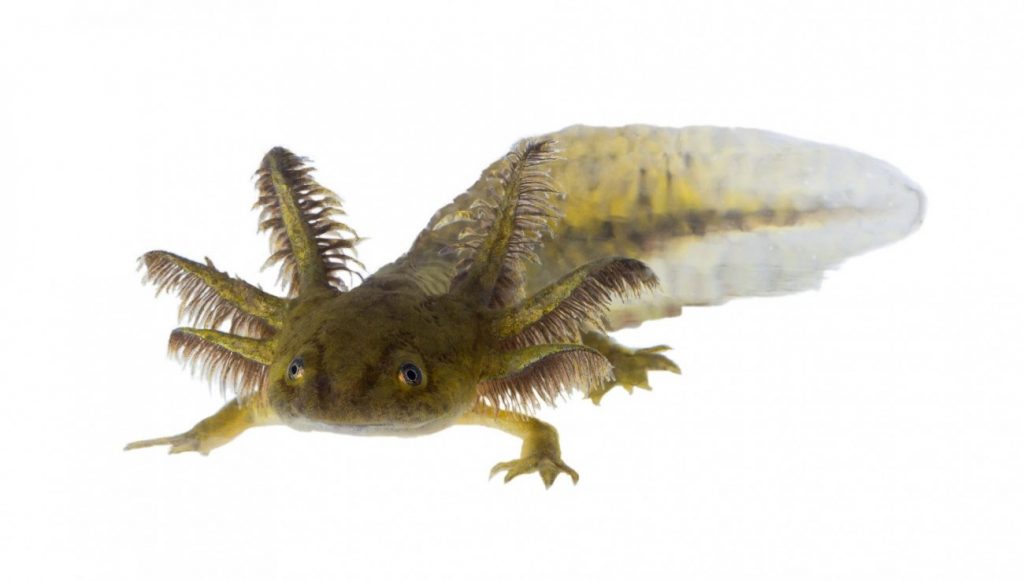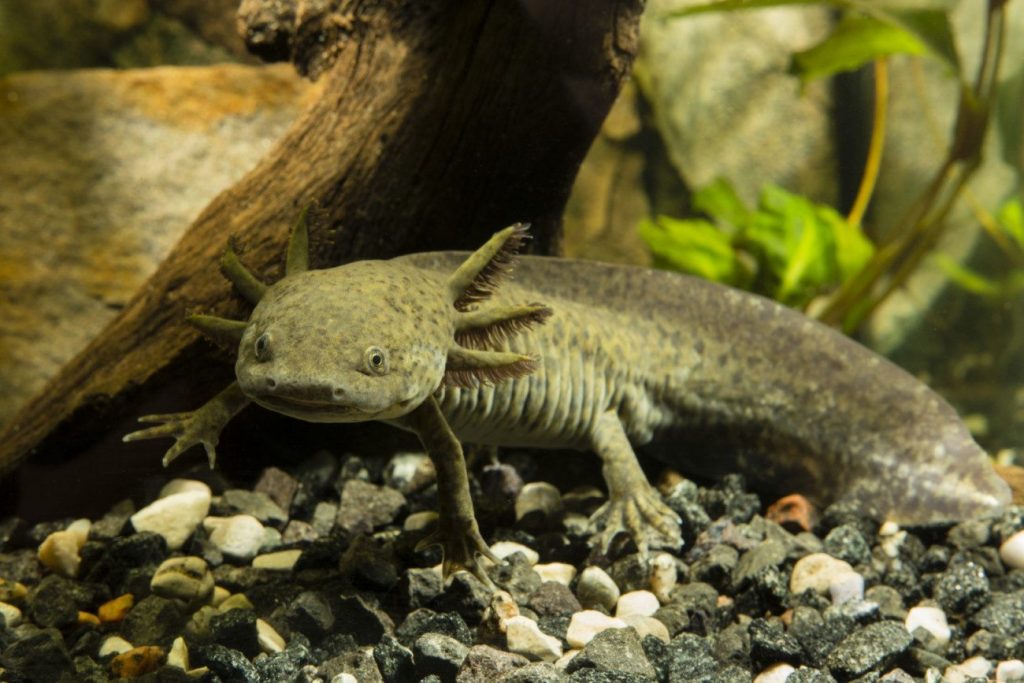AXOLOTL
(Ambystoma mexicanum)
FOR THE MONTH OF JANUARY, $19.99, WHILE SUPPLIES LAST.
What is the most important factor in determining the likelihood of long-term survival for a particular species? Would it be size, speed, strength, intelligence, or some other measurable physical characteristic? In our opinion, it would be something a little harder to measure, but readily apparent none the less, if you know where to look. We’re referring to adaptability, and we would argue that a species ability to adapt to it’s environment is the single most important predictor of long term survival on our planet. (Although in our current time period, an equally compelling argument can be made for a species’ value to humans.) Our January pick for animal of the month is lucky enough to be both incredibly adaptable, and at the same time, highly valuable to humankind! It may not be the cutest pet, but it is certainly one of the most interesting, and we are excited to highlight the amazing Axolotl (Ambystoma mexicanum) by naming it our January Animal of the Month!
The Axolotl is a salamander, and while you likely wouldn’t guess this from looking at it, is very closely related to the Tiger Salamander. What makes this species so unique is the fact that it remains in it’s larval form throughout it’s entire life. Most amphibians undergo metamorphosis from egg to larva and then from larva to adult form. Axolotls however, are neotenic, meaning they reach sexual maturity/adulthood without undergoing metamorphosis. Even in larval form, Axolotls will reach an adult size of 6”-12”, which is much larger than most other amphibian larva.
The Axolotl is fully aquatic, and native to only 2 lakes near Mexico City in Central Mexico; Lake Xochimilco and Lake Chalco. Unfortunately, Lake Chalco no longer exists, and Lake Xochimilco has been reduced to a series of canals, as both were artificially drained long ago to prevent flooding in Mexico City. These lakes were located on a high altitude plateau, surrounded by soaring volcanos and mountains. The terrestrial environment there is steep, rocky, and sparsely vegetated. It is likely that neoteny is a survival mechanism for Axolotls, as the species faced little chance of success living a terrestrial life, but it was able to thrive and prosper in an aquatic environment.
Sadly, due to habitat loss and pollution, Axolotls are now considered Critically Endangered, and the days for the wild population are surely numbered. Luckily, these animals will live on, if only in captivity, due to their high value as research animals, as they are excellent specimens for scientific study. Axolotls were actually the starting point for research on Neoteny, and are still studied to further understanding on the subject today. Scientists have learned that Axolotls fail to metamorphose due to a dietary lack of iodine, which is used in the production of a thyroid stimulating hormone. It has even been discovered that they can be induced to metamorphose with an iodine injection, resulting in an adult form resembling a terrestrial tiger salamander!
While Neoteny is one area of scientific study where Axolotls are invaluable research specimens, most attention is paid to them due to their amazing healing abilities. Typical wound healing in animals involves the growth of scar tissue, which is not the same as the original damaged tissue. Axolotls do not heal by scaring, and are therefore capable of the regeneration of entire appendages! They can even restore damage to less vital organs, including their brains! Of further interest is the fact that Axolotls readily accept tissue and organ transplants from other individuals, and overtime, will even restore some organs to full functionality! Somehow, netoney plays a role here, as this fantastic ability to regenerate and restore is diminished significantly in individuals that have undergone induced metamorphosis into their adult form.
Scales ‘N Tails highly recommends Axolotls as we believe that make great pets for beginners and experts alike. While most would not consider them the most attractive animals, their appearance is certainly unique. One of the reasons for they are attractive research animals is the fact that they thrive, and readily reproduce, in a captive environment. They do not require much in the way of supplies and equipment, and what little they do require is fairly easy to provide. It is not an animal that should be handled, but they are easily trained to hand feed, which allows for positive interactions between pet and owner.
CARING FOR A PET AXOLOTL
Caring for a pet Axolotl could not be easier. We recommend keeping adults in a 10-gallon aquarium. The water level should be at least 6” deep, but if a screen top isn’t provided, should not be filled to the top as they are able to leap out. Water temperature should be kept in the range of 64°-70° F, so unless it’s going in a very cold room, a water heater should not be necessary. Substrate is not necessary either, but can be used provided proper consideration is taken when selecting what to use. Axolotls feed by opening their mouths and sucking prey in. The problem with this is that they can also suck up other small items in the process. Pieces of gravel or other debris can cause fatal blockages in the gut, so if a substrate is desired, we recommend a gravel that is made up of individual pieces that are larger than the animal’s head. Very fine sand is also a good substrate as it will not clog the digestive tract if if ingested.
Water filtration is not required either, provided you are willing to change the water fairly frequently, but we do recommend one as it will certainly make the animal easier to care for. A strong current can be very stressful to Axolotls, so we recommend placing a décor item, like a piece of wood, or a rock, directly in front of the filter output to disperse the strong stream of water most filters will pump out. As will all aquatic animals, the chlorine found in tap water is harmful, so always be sure to use a water conditioner when changing the water.
Pet Axolotls can, and should, be fed a variety of appropriate food items. Earthworms, frozen or live Bloodworms, Wax Worms, Turtle Pellets, and Salmon Pellets are all readily available food sources. While they will happily eat small feeder fish, like gold fish and minnows, these should be avoided as they often carry parasites that could be harmful to Axolotls. As previously mentioned, with just a little encouragement and training, Axolotls will readily come to the top and take food right out of a hand or a pair of tweezers. We often feed them in the store this way and recommend this activity as it helps nurture the bond between owner and pet.
While also not a necessity, we always recommend adding some décor items to your Axolotl tank. Caves, driftwood, and live and artificial plants will provide the animal with a greater sense of security while at the same time enhancing the look of the enclosure. Axolotls do not require any lighting, but they will receive no negative impact from aquarium lighting that must be provided for live plants. Again, take care not to introduce anything into the environment that could potentially get sucked up during feeding.
If you provide the right environment for your Axolotl, then you’ll be able to enjoy your pet for a long time. Captive Axolotls can live up to 15 years with appropriate care and diet, but generally, 10 years is about average.

Finally, we wouldn’t be doing our Animal of the Month justice if we didn’t make it an affordable pet option. So for the month of January, while supplies last, we will have well started, captive bred Axolotls available for the unbeatable price of $19.99! So if you’re interested in a fascinating new aquatic pet amphibian, there has never been a better time to get one!

